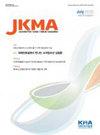Analysis of factors affecting the unbalanced distribution of physicians’ working regions in South Korea
IF 0.5
Q3 MEDICINE, GENERAL & INTERNAL
引用次数: 0
Abstract
Background: Many countries need help with the problem of an unbalanced distribution of physicians and hospitals. Moreover, various policies and strategies have been proposed to solve this problem. This study aimed to examine the determinants of the unbalanced distribution of physicians.Methods: From the 2020 Korean Physician Survey data, 4,181 physicians practicing in Korea were limited to the subjects of the study. We analyzed the factors influencing physicians’ choice of practice location and their willingness to change their practice location from an urban to a rural area.Results: The region of physicians’ hometown, medical school, and residency training hospitals determined their choice of practice location. The type of affiliated healthcare organization and the location of physicians’ hometown, medical school, and residency training hospitals affected their willingness to change their practice location from an urban to a rural area. Furthermore, the concordance rate of the regions of physicians’ hometown, medical school, and residency training hospitals with the region of their practice location was 24.9%.Conclusion: In South Korea, policies for doctors have been designed without considering why they are reluctant to work in rural hospitals. To have a balanced distribution of physicians and hospitals, it is necessary to accurately analyze the status of medical resources based on regions and identify the current and future medical demand. The social situation, such as future demographic change and regional extinction, must also be fully considered. Furthermore, policies should be implemented that encourage physicians to work in rural hospitals.韩国医生工作区域分布不平衡的影响因素分析
背景:许多国家需要帮助解决医生和医院分布不平衡的问题。此外,人们还提出了各种政策和战略来解决这一问题。本研究旨在探讨医师分布不平衡的决定因素。方法:从2020年韩国医生调查数据中,4181名在韩国执业的医生被限制为研究对象。我们分析了影响医师执业地点选择的因素以及医师从城市执业地点转向农村执业地点的意愿。结果:医师的家乡地区、医学院地区和住院医师培训医院地区决定了医师实习地点的选择。附属医疗机构的类型、医生的家乡、医学院和住院医师培训医院的位置影响他们将执业地点从城市改为农村的意愿。医师的家乡、医学院和住院医师培训医院地区与执业所在地地区的符合率为24.9%。结论:在韩国,医生政策的制定没有考虑到他们为什么不愿意在农村医院工作。要实现医师和医院的均衡分布,就必须根据区域准确分析医疗资源状况,识别当前和未来的医疗需求。社会形势,如未来的人口变化和区域灭绝,也必须充分考虑。此外,应实施鼓励医生到农村医院工作的政策。
本文章由计算机程序翻译,如有差异,请以英文原文为准。
求助全文
约1分钟内获得全文
求助全文
来源期刊

Journal of The Korean Medical Association
Medicine-General Medicine
CiteScore
0.50
自引率
0.00%
发文量
84
审稿时长
4-8 weeks
期刊介绍:
The Journal of the Korean Medical Association (JKMA) is the official peer-reviewed, open-access, monthly journal of the Korean Medical Association (KMA). It contains articles in Korean or English. Its abbreviated title is ''J Korean Med Assoc''. The aims of the Journal include contributing to the treatment of and preventing diseases of public health importance and to improvement of health and quality of life through sharing the state-of the-art scientific information on medicine by the members of KMA and other national and international societies.
 求助内容:
求助内容: 应助结果提醒方式:
应助结果提醒方式:


